Economic Report on Scottish Agriculture 2015
Economic Report on Scottish Agriculture 2015 presenting an overall picture of Scottish agriculture using data from the various agricultural surveys that RESAS manage.
Annex B
Milk production in 1949
“Milk is the most important single product of Scottish agriculture. In 1948/49 the output of milk on Scottish farms was 215 million gallons, valued at £28 million; this represented 27 per cent of the total value of Scottish agricultural output.”
So begins one of three short papers[17] on milk production, included in Scottish Agricultural Economics Volume II, published in August 1951. Nowadays milk is relatively less important; in 2014 milk was valued at £447 million (or about £13 million in 1949 prices), or 15 per cent of output. Milk production has however increased since then, with 294 million gallons produced in the 2013/14 quota year.
The three papers contain some other statistics that make a stark comparison with today. The data on dairy herd size includes any holding that has dairy cows and heifers in milk, or cows in calf. There were 8,600 such holdings, with an average number of 31 cows per holding, The paper notes that in England and Wales the average was only 15. The published table has ‘81 and over’ as its largest category, obviously considering this large enough not to necessitate further divisions, with 200 holdings in that category.
Chart 1: Size of farms with dairy cattle
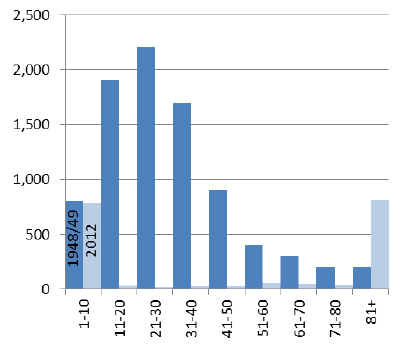
The most recent year for which we have comparable data definitions is 2012. There were by then only 1,840 such holdings, with an average of 92 head per holding, and with the top 200 holdings now being of size 217 or greater, rather than 80 plus. However, excluding the large number of holdings with just a few dairy cattle (actually a similar number to in 1948/49), nearly all the other holdings with dairy cattle in 2012
Chart 2: Price and volume of milk, 1939-2014
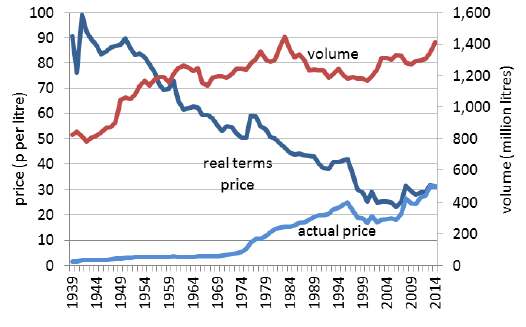
would be in the uppermost category of the 1948/49 table.
In the late 1940s yield per cow was around 700 gallons, a half of what it is nowadays, and milk prices were about 30d per gallon, which is 2.7p per litre, or, we estimate, about 88p per litre in today’s prices.
That real terms price fell steadily until about 2007. The total volume produced, about
one billion litres, was increasing slowly until the 1960s, when it reached the 1.2 billion litres that was broadly still the norm until the last decade.
The first of the three papers in the report focuses on changes in the costs of milk production. The most important cost was feed, which accounted for over half of all costs. Feed costs increased 13 per cent between 1948/49 and 1949/50. This was due to the removal of part of the subsidy on feed in April 1949. The price of concentrates rose 40 per cent, pushing farmers to look elsewhere. While 1948 was a very wet year, with high hay and cereals prices, 1949 was an excellent year for both, helping farmers looking for an alternative. However, dairy farms actually bought more concentrates, pushing up yield, particularly in winter.
The following charts are not necessarily comparable, the first showing specific costs of milk production collected specifically for the report, whereas the second, from the Farm Accounts Survey, shows cost for dairy cow enterprises. However, it would appear that the cost of labour, and to a lesser extent feed, were more important in 1948/49, with a much smaller value of livestock purchased.
Chart 3: Milk production costs, 1948/49
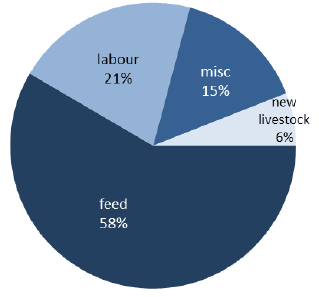
Chart 4: Dairy cow enterprise costs, 2013/14
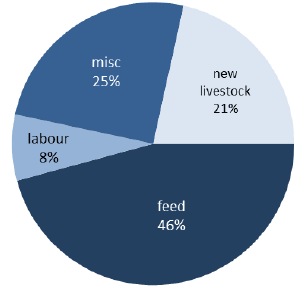
The third paper on milk in the report addressed the farmer’s problem of how to utilise home-grown foods and bought-in feed (whether rationed or not), balancing the two sources in a way that maximised his net returns. For the analysis “self-contained”
herds and “the flying herd” were considered separately. The author accepts that “the particular results obtained have no universal validity… however, although conditions will vary between farms, the principle are generally applicable”. Hence it was not meant to provide answers, or even a formula for you to plug in your local data, but more a guide as to how one might approach the question analytically, using the skilfully drawn diagram below.
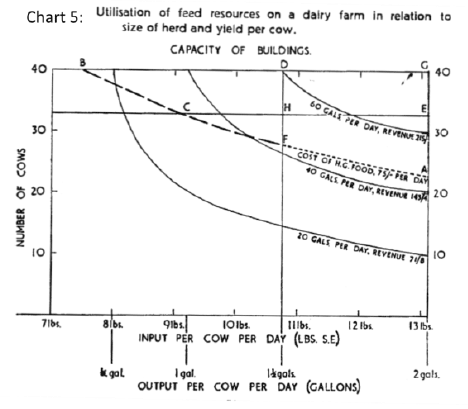
A large number of historical publications are available at www.gov.scot/Topics/Statistics/Browse/Agriculture-Fisheries/Publications/histagstats
Contact
Email: Agricultural Statistics
There is a problem
Thanks for your feedback